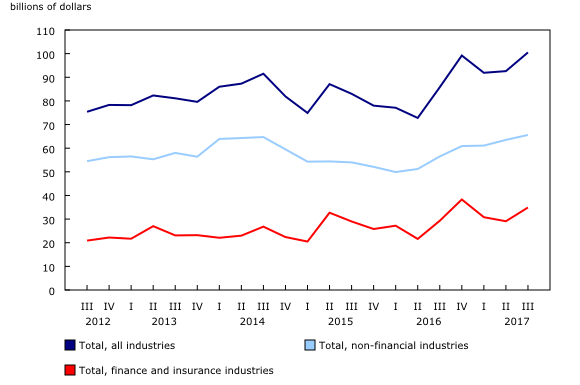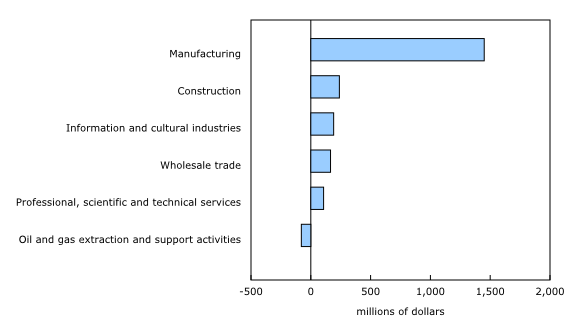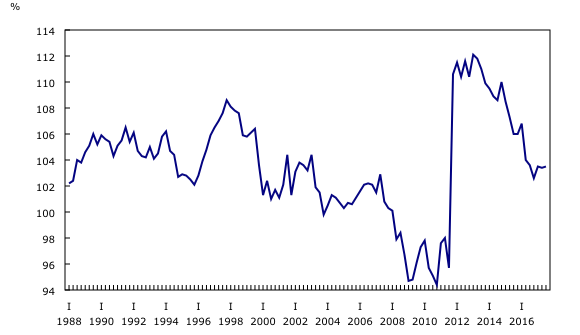Quarterly financial statistics for enterprises, third quarter 2017
Archived Content
Information identified as archived is provided for reference, research or recordkeeping purposes. It is not subject to the Government of Canada Web Standards and has not been altered or updated since it was archived. Please "contact us" to request a format other than those available.
Released: 2017-11-24
$100.5 billion
Third quarter 2017
8.5% 
(quarterly change)
Overall operating profits
Canadian corporations earned $100.5 billion in operating profits in the third quarter, up $7.9 billion or 8.5% from the second quarter. The financial industries were the main drivers of growth in the third quarter.
Compared with the third quarter of 2016, operating profits for Canadian corporations were up 17.2%.
Non-financial industries
In the non-financial industries, operating profits increased 3.3% from the second quarter to $65.6 billion in the third quarter, as operating revenues increased 0.3% or $2.4 billion. Operating profits were up in 11 of 17 non-financial industries.
Compared with the third quarter of 2016, operating profits for Canadian non-financial corporations increased 16.1%.
Operating profits rise in retail and wholesale trade
Operating profits in retail trade rose 0.7% from the second quarter to $5.4 billion in the third quarter, led by the food and beverages stores industry (+3.9%).
In wholesale trade, operating profits increased 2.3% from the second quarter to $7.2 billion. A 16.7% increase in the machinery, equipment and supplies merchant wholesalers led the gain.
Manufacturing sector: Petroleum and coal products manufacturing operating profits rebound
Operating profits in manufacturing were up 11.2% from the second quarter to $14.4 billion in the third quarter, with 9 of 13 manufacturing industries reporting gains.
Most of the increase in operating profits was attributable to petroleum and coal products manufacturing, up 567.8% to $1.6 billion in the third quarter—mainly due to higher oil prices. This followed a $1.2 billion decline in the second quarter.
Operating profits in food and soft drink manufacturing rose 7.1% to $1.8 billion.
Operating profits in motor vehicle and parts manufacturing declined 14.6% from the second quarter, due in part to longer than usual maintenance shutdowns in assembly plants and changes to vehicle models being manufactured in Canada. Production was also somewhat affected by strikes in the automobile sector.
Excluding petroleum and coal products manufacturing, operating profits in the manufacturing sector rose 0.4% to $12.8 billion.
Operating profits in the oil and gas extraction and support activities industry declines
The oil and gas extraction and support activities industry reported an operating loss of $450 million in the third quarter, down 21.3% from the second quarter.
Although the oil and gas extraction and support activities industry started to report lower operating losses since the first quarter of 2016, the third quarter marked the first time that the industry's losses grew. The decline was attributable to lower operating revenue, due to the maintenance shutdowns in Newfoundland and Labrador that affected conventional oil production.
Financial industries
Operating profits up in the financial sector
Operating profits in the financial industries rose 20.0%, up from $29.1 billion in the second quarter to $34.9 billion in the third quarter.
Operating profits for depository credit intermediation increased 9.6% from the second quarter to $12.2 billion in the third quarter. This $1.1 billion increase in operating profits was the result of higher interest revenue and lower operating expenses.
Operating profits for insurance carriers and related activities rose 196.8% to $6.7 billion in the third quarter. Life, health and medical insurance carriers ($4.7 billion) led the gain. This sharp increase was the result of fair value adjustments to actuarial liabilities, which decreased by $8.1 billion in the third quarter.
The marked decrease in fair value adjustments was likely influenced by valuation changes resulting from the Bank of Canada's rate hikes in July and September.
Net income for the life, health and medical insurance carriers rose 9.2% to $2.5 billion in the third quarter. Write offs and valuation adjustments mitigated the large increase in operating profit on lower actuarial liabilities expenses.
Property and casualty insurance carriers' operating profits declined 15.3% to $1.2 billion.

In celebration of the country's 150th birthday, Statistics Canada is presenting snapshots from our rich statistical history.
Total mortgage and non-mortgage loans provided by the finance and insurance industries represented 103.8% of their total deposits at the end of 1988, while representing 103.5% by the third quarter of 2017.
While the assumption is that these industries only lend money obtained from deposits, a percentage above 100% indicates they are using additional sources of funding to provide loans, such as the issuance of bonds, revenues from other services and investments, securitization of assets and so on.
From the first quarter of 1988 to the third quarter of 2017, there have been two points in time that reflect important changes in the industry that affected the seemingly stable portion of loans financed by deposits.
Starting in the first quarter of 2008, the finance and insurance industries provided less loans than the amount they carried as deposits. This possibly reflected the economic conditions due to the financial crisis and the resulting credit tightening.
In the third quarter of 2011, there were signicantly more loans provided by these industries not being financed only by their deposits. This was due to the adoption of International Financial Reporting Standards by Canadian enterprises. These new accounting standards required lenders to show all their loans on their balance sheets, including those that had been used in the securitization of assets.
The percentage of loans in relation to deposits as of the third quarter of 2017 appears to be returning to the levels observed before these two particular events.
Note to readers
Data on quarterly profits in this release are seasonally adjusted and expressed in current dollars. Financial data for the first and second quarters of 2017 have been revised.
For information on seasonal adjustment, see Seasonally adjusted data – Frequently asked questions.
Quarterly financial statistics for enterprises are based on a sample survey and represent the activities of all corporations in Canada, except those that are government-controlled or not-for-profit. An enterprise can be a single corporation or a family of corporations under common ownership and/or control, for which consolidated financial statements are produced.
Profits referred to in this analysis are operating profits earned from normal business activities. For non-financial industries, operating profits exclude interest and dividend revenue and capital gains/losses. For financial industries, these are included, along with interest paid on deposits.
In this release, all profits are operating profits unless otherwise stated. Operating profits differ from net profits, which represent the after-tax profits earned by corporations.
For more details on the concept of actuarial liabilities, consult the page Actuarial Liabilities.
Real-time CANSIM tables
Real-time CANSIM tables 187-8001 and 187-8002 will be updated on December 11. For more information, consult the document, Real-time CANSIM tables.
Next release
Financial statistics for enterprises for the fourth quarter of 2017 will be released on February 22, 2018.
Products
Aggregate balance sheet and income statement data for Canadian corporations are now available in CANSIM at the national level for 22 industry groupings.
The publication Quarterly Financial Statistics for Enterprises (61-008-X) is no longer released. Data from the Quarterly Survey of Financial Statements are available in CANSIM.
Contact information
For more information, or to enquire about the concepts, methods or data quality of this release, contact us (toll-free 1-800-263-1136; 514-283-8300; STATCAN.infostats-infostats.STATCAN@canada.ca) or Media Relations (613-951-4636; STATCAN.mediahotline-ligneinfomedias.STATCAN@canada.ca).
- Date modified:




